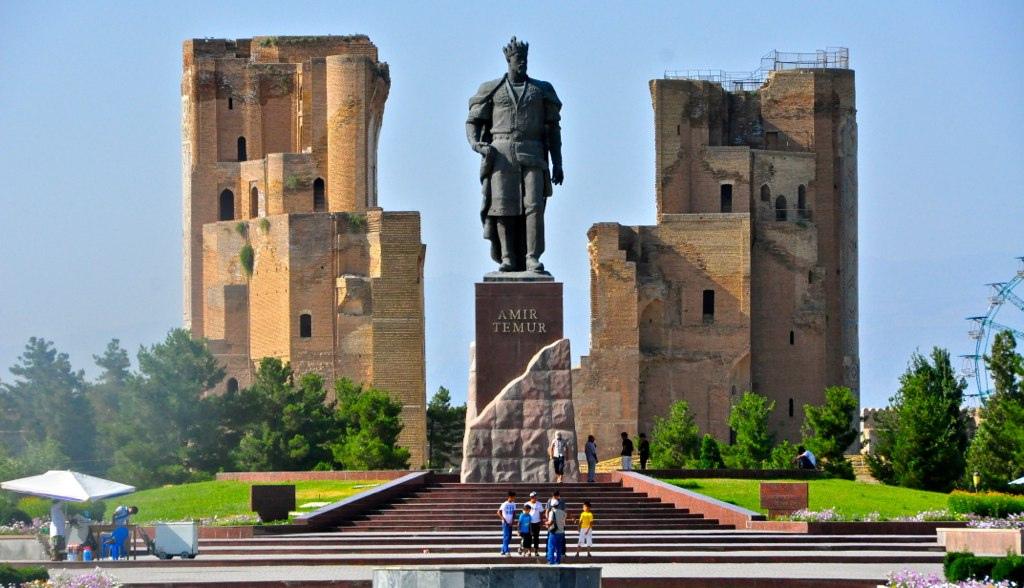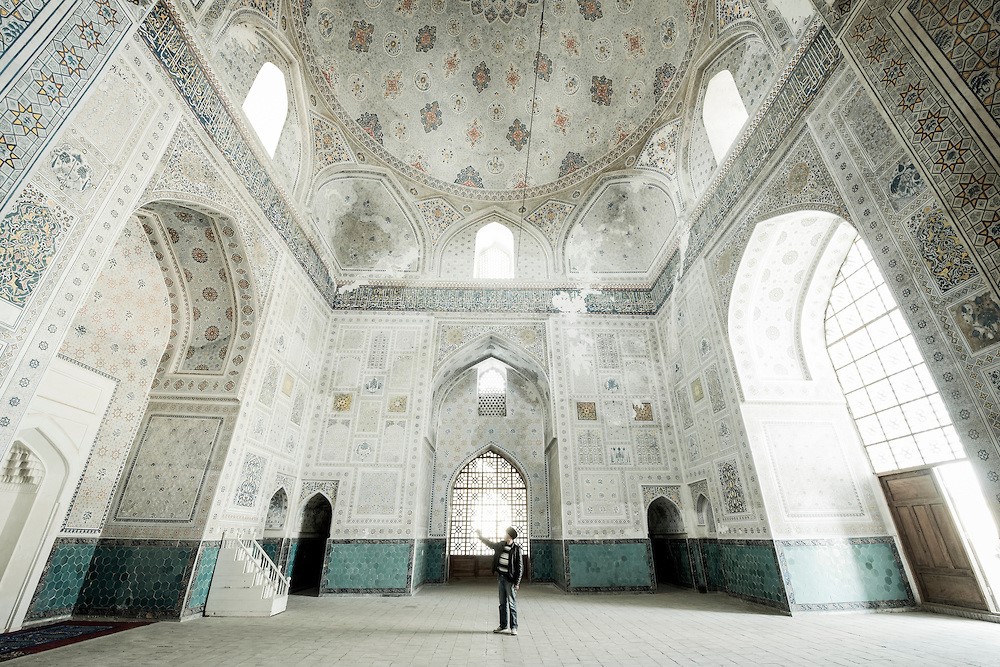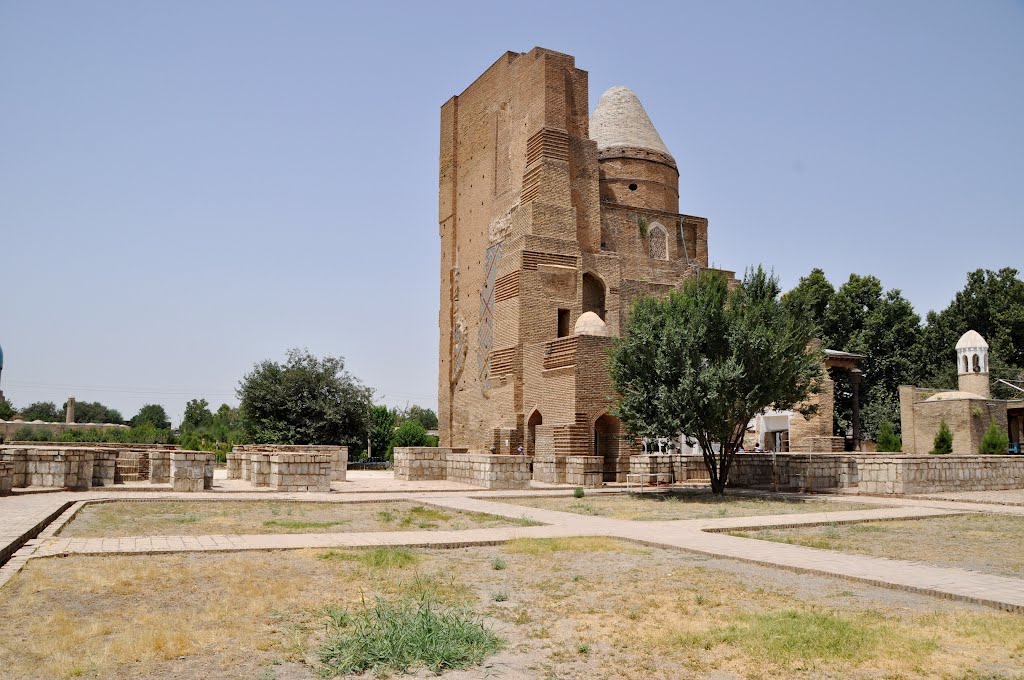Shakhrisabz is one of the most beautiful and colorful cities in Uzbekistan, located 50 miles south of Samarkand. This 2,700-year-old city has played a significant role in the history of the Central Asian region. Formerly Shakhrisabz was the capital of the ancient state of Sogd and was known in the Middle Ages as the famous city of Kesh. In 329 BC, Alexander the Great conquered the city and soon Hellenistic culture appeared.
Ak-Saray Palace (A World Heritage Site). Several monumental buildings were built in Shakhrisabz in the time of the Temurids. The most magnificent of them is Ak-Saray Palace. Amir Temur intended to make Shakhrisabz the second capital of his empire, no less sumptuous than Samarkand. The construction of the palace began in 1380 and lasted more than 25 years. It is known that architects and handicraftsmen from Khorazm, shortly before subjugated by Temur, took part in the construction of the palace.

According to the records of Ruy Gonsalez de Clavijo, the envoy of the King of Castile to the court of Amir Temur, they entered the palace “by a very broad and lofty door way, ornamented with gold and blue patterns on glazed tiles, richly and beautifully worked. On the top of this doorway there was the figure of a lion and a sun, which are the arms of the lord of Samarkand…” The door led to a grand reception hall. The luxury of decoration of the palace was supplemented with floors finely wrought in tiles, some of which was found during the excavation works.
Kok-Gumbaz Mosque. In 1435, in Dorut-Tillavat that stands opposite Shamsiddin Kulol Mausoleum, the Kok-Gumbaz Mosque was constructed—the biggest cathedral Friday mosque in Shakhrisabz. The inscription on the portal announces that the mosque was constructed by Ulugbek on behalf of his father Shakhruh.
Adjacent to the mosque there once were summer galleries. Those that survived are the bases of square pylons that supported arches overlapped with numerous small domes. Thick pylons of the eastern portal were decorated with ornamental patterns, whereas its tympanum (semi-circular decorative wall surface over an entrance) was covered with a mosaic girikh star pattern typical of Ulugbek’s times. In the pylons of the main portal there were built winding stairs leading to the roof. The tower resembling a small minaret flanks the buttresses of the pylons. Its lower part is faced with marble, whereas its top is crowned by a capital covered with majolica. The northern and southern façades have open passageways which lead inside the mosque.

For centuries, Kok-Gumbaz Mosque was the principal cathedral mosque of Shakhrisabz. As early as Ulugbek’s time, to the east from the mosque there appeared a cemetery where were buried nobility and clergy from Barlas clan, to which the Temurids belonged. Here, on the marble tombs one can find the names of military leaders who took part in the campaigns of Shakhruh and Ulugbek.
Gumbazi-Seyeedon Mausoleum. Two years after the construction of the Kok-Gumbaz Mosque had been accomplished, Ulugbek ordered to construct a burial-vault, subsequently known under the name of Gumbazi-Seyeedon Mausoleum, or “Dome of the Seyeeds,” right against the southern wall of Shamsiddin Kulol Mausoleum.
A small, graceful, one-chamber mausoleum is crowned by a blue dome on a high drum inlaid with mosaic inscription in kufic script. The nearly square building was constructed in the architectural style typical for Ulugbek’s times. The western entrance is decorated with a small, slightly protruding portal and a wooden door faced with deep three-layer carvings representing vegetal ornaments interlaced with epigraphic inscriptions.
The burial vault of seyeeds is one of the best works of Central Asian architects of the times of Ulugbek.
Dorus Saodat memorial complex. Jahangir’s mausoleum. (A World Heritage Site). Along with the construction of Ak-Saray palace, in 1380, the Dorus Saodat complex was begun. Of this complex, only two constructions survive today: Jahangir’s mausoleum and crypt for Temur, where he was never buried. A dismal event motivated Temur to start building the memorial complex. In 1376 his eldest son Jahangir, whom the ruler loved dearly and intended to make his successor, suddenly died at the age of 22. The citizens of Samarkand mourned the loss of the crown prince—“a fair prince, a gallant warrior who flashed by on the earth like a rose.” After the death of his beloved son, Temur himself gave way to an overwhelming grief.

On the walls, arch rings and medallions are carved in sulus script quotations from the Koran and inscriptions that read: “The Command belongs to Allah alone. He is Eternal,” and “In Allah’s hand is all Good, over all things He has power.” The fate willed it that the body of Amir Temur should be buried not in the crypt of Shakhrisabz, but in Gur-Emir mausoleum in Samarkand.


